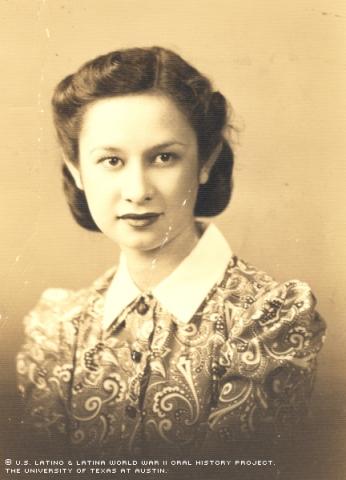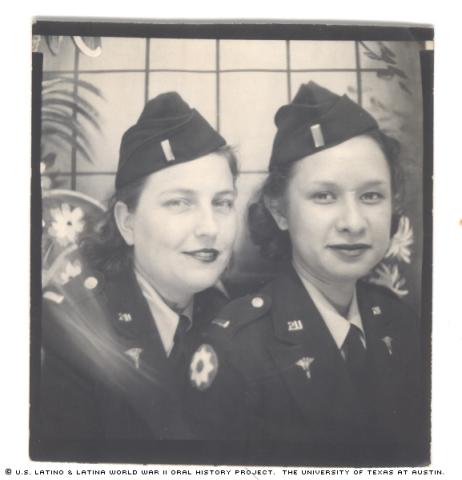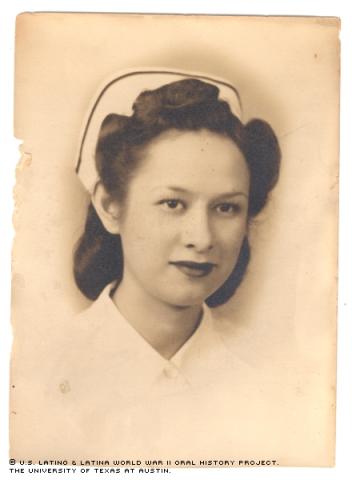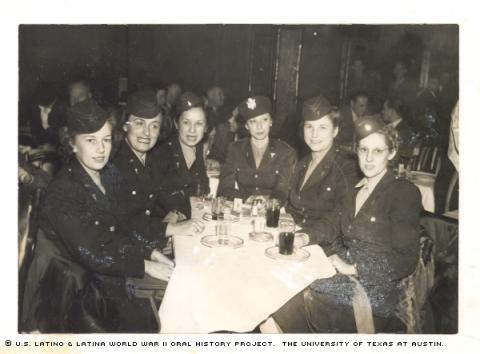



By Joanne R. Sanchez
San Antonio, TX - When she was seven years old, Rafaela Muñiz Esquivel - the second oldest in the family that would eventually include 15 children - began caring for her brothers and sisters. Rafaela stayed home from school when her mother needed her to run errands. By the time she was nine, there were already six children in the Muñiz household, including her brother Fernando, who was born with Down's syndrome.
"My mother ... used to leave me in charge," she recalled. "I would stay with the kids ... she could always depend on me to take care of them."
That pattern of being a responsible caregiver which began so early in life, would serve her well during World War II. She became an Army nurse in the United States and also in the European Theater.
The Muñiz family had three children who served their country during the war. In addition to Rafaela, Rodolfo was a civilian aircraft mechanic stationed in England, and her brother Roger served in an anti-aircraft battalion in the European Theater.
"Mother never seemed to worry too much about me," Esquivel said. "She knew [that] I knew what to do. ... I think she was more concerned about [my brothers]. She knew they would be at the front."
From her San Antonio home where she and her husband Efrain (Frank) have lived for the past 50 years, Esquivel spoke of her family and about her life in San Antonio during the Depression.
Her father, Rafael Muñiz was born in San Nicolas de los Agustinos, Guanajuato, Mexico. Her mother, Raquel Cuevas Muñiz was born in Puebla, Mexico. The two married in San Antonio in 1917 when Raquel Cuevas was just 15 years old.
Rafael Muñiz was a cement finisher and also did carpentry and other labor. In 1929, he decided to buy land and build a home for his family, which at that time included six children. They moved into the house before it was completed.
"We had a room with just the floor," Esquivel recalled.
On the weekends, friends and family came and helped her father finish the house. As more children were born, more rooms were added to the house.
It was shortly after the family moved into their home that her father's work began to get scarce, so he left for Monterrey, Mexico to help build a brewery. Back home in San Antonio, Mrs. Muñiz sewed dressed and aprons; she bartered these for fruit and vegetables when the fruit peddler made his daily rounds by their house on his horse and wagon.
When Rafaela was 13 or 14, she and some of her siblings worked in a pecan shelling business in San Antonio. They did not like this kind of work.
"We didn't last too long because it was dirty and hard," she said, with a look of distaste. "As it was we didn't have enough clothes and this would stain your clothes."
Esquivel's mother and her aunt told her about Rochester Handkerchief Company, which paid people to hand-stitch edging and applique their product. Rafaela and her sister Rachel helped with the sewing and were paid from $1.50 to a little more than $3 per dozen.
When Rafael Muñiz returned from his job in Monterrey, he found little work. Later, he was hired by the Works Progress Administration (WPA) and he helped rebuild "La Villita," the site of the original settlement in San Antonio.
Despite hard times, Rafaela enjoyed the weekends because that was when her family would get together with her grandmother and uncles.
"I always looked forward to the weekend," she said, "church, picnics and family together."
The Muñiz children all went to public school. It was at Ira Ogden Elementary School, a school that included both Mexican Americans and Anglos, where several of them had the spellings of their names changed by their teachers. Esquivel told of her tenacity when her first grade teacher tried to change her name.
"She would erase the 'f' and put 'ph,' and I would erase it and 'f'" she said.
A teacher changed her sister's name Raquel to Rachel; Alicia Maria because Mary Alice; Rodolfo, Rudolph; and Raul's name was changed to Roy. Other than the name changes, Esquivel said that they were not prohibited from speaking Spanish at school, and that they got along well with the students and teachers.
During junior high, Rafaela made up her mind that she would become a nurse, so when she went on to San Antonio Technical High School in 1935, she took academic courses to prepare her for nursing school. In high school, she joined the Glee Club, "something that did not require money," she said.
She recalled that Mexican Americans could join any of the clubs at San Antonio Tech, but some of the clubs were costly. She and her siblings walked two miles to school everyday. Except for Fernando, who had Down's syndrome, all of the Muñiz children graduated from high school.
Esquivel graduated in 1938, though she spent another year at the school taking extra courses to ensure that she would be prepared for nursing school, should she find a way to go. She compared costs of nursing programs at Santa Rosa Hospital, Westmoreland College (now Trinity University) and found them too expensive. She then walked two miles to Robert B. Green Memorial Hospital to find out their enrollment requirements. Robert B. Green's tuition cost was $60, less expensive than the other two - but still beyond the family's means.
Esquivel decided to talk to her father.
"He said, 'OK. Now we can do something,'" she recalled. "So he went and got a loan ... He [asked], 'What else do you need?' I said, 'I require clothes.' So he opened a charge account at what is now Dillards. It used to be Joske's. So we got a charge account there and got all the ... white clothing that I needed. Boy, that was a happy day!"
Four months later, Esquivel received her first pay check from Robert B. Green School of Nursing. It was $4 for the month. She used much of that money to buy herself a wrist watch to replace her broken one. The second year to nursing school, she received $5 a month; and in the last year, it increased to $6. She graduated from nursing school in May 1942 and completed all of her nursing hours in August. She was one of five Mexican Americans to complete nursing school that year at Robert B. Green Memorial Hospital; four of them would join the service.
It was about this time when the Red Cross asked for volunteers to join both the Red Cross and the Service. She joined the Army Nurse Corps (The Army Nurse Corps became a part of the Army by an act of Congress in April 1947). Accepted as a second lieutenant in the reserve, she reported for duty on October 1, 1942.
"I always looked forward to traveling and maybe working ... in the civil service as an R.N.," she said. "But that's not the way it happened."
She was sent to Fort Sam Houston in San Antonio for basic training. There, at Brooke General Hospital, she worked first in the women's ward and then in the obstetric ward, where she remained for the next 13 months.
The nurses worked 12-hour shifts with one day off, but if they worked split shifts, sometimes they could arrange to have a weekend free.
In November 1943, the nurses at Brooke General Hospital were transferred to other locations. She and her friends, Helen Louise Hayes, Mary Jane Baker and Frances Bennison were sent to Fort Sill, Oklahoma. Here, Esquivel worked in various wards, including respiratory, dental, eye and medical. The medical ward was where patients who were very ill were sent. Some of these patients had been at the war front and a few died of their wounds. One had nightmares as a result of his experiences, Esquivel said.
In November 1944, Esquivel was sent to Camp Barkley in Abilene, Texas and then to Camp Kilmer in New Jersey. She, along with her friend Helen Louise Hayes, left for Europe on the Queen Mary on December 9. They arrived in the United Kingdom on December 19.
Aboard the ship, they had two meals a day and slept six to a berth. For safety reasons, the nurses had to wear lifejackets at all times and were not allowed to go on deck.
Their destination was their home hospital, the 242d General Hospital at Sissonne, France. When they arrived at a town near Sissonne, they were happy to find their quarters had been heated in anticipation of their arrival.
"I was so cold that when I got close to the stove, I burned my hand and didn't even know it," she said.
The nurses were quartered in an old cavalry post where they had to "make their own heat" out of whatever they could find, Esquivel recalled. She once even upset her roommate by burning curtains and a cover for a shelf that her roommate had made from burlap.
Esquivel was briefly sent to another camp, where they called for the most "stable" nurses, she said. That is when she was assigned to the 101st Evacuation Hospital in Luxembourg. This was where casualties were sent after they'd been given first aid and treated at a field hospital. It was at an evacuation hospital where a decision would be made about where to send a patient - some were sent to surgery, others to England and some to the United States.
"That was where they used to bring them [the wounded] back by loads," she said. "[We were] always on the go ... most of the time we were dressed. We didn't have time. There was no way that we could really get undressed [to sleep]."
Here, they received both American and German personnel. The patients were carried in on litters, which were placed on top of cots until it was determined if they needed to go to surgery or a specialized ward. Then, a staff person would move the patients on the litter, freeing the cot for another litter.
The 101st Evacuation Hospital was once the summer palace of the Duchess of Luxembourg.
"It could have been beautiful before all those casualties were there," Esquivel said. "There was a living room where I worked ... there was a mantelpiece on one side, a mirror on one side, a candelabra ... and real nice light fixtures. The stairway went up on one side and down on the other. The grounds were big, but I never went on the grounds."
However opulent their surrounding, their daily tasks were anything but.
"Of course, when we had our baths, if you want to call them that, we took them out of helmets," she recalled.
From Luxembourg, Esquivel was sent on to a makeshift hospital in Germany near Koblenz in early 1945. The staff that set up the hospitals always went first and the rest of the staff followed later.
The hospital in Germany was set up in a monastery. They were about five miles away from Patton's 3rd Army. Although the hospital was never bombed, the sounds of bombs exploding were often heard in the distance and flashes of light could be seen at night.
"We were busier ... in Germany because it seemed like they were coming in droves," Esquivel said.
In addition to soldiers, a number of civilians, including women and children, were also brought in.
"[We] had a couple of German ... SS, real strong looking. Both had stomach wounds and they had rubber tubes ... 'wagenstien suctions' ... One of them used to get up and pull it out from the other one and pull his out," she said. "The following day, I found ... they both had died. I guess they didn't want to be taken prisoner."
After the war ended, Esquivel was given the choice to stay or return home. She was anxious to go home, so she chose to leave.
Esquivel said the war affected her life in many ways.
"I think I missed most of my youth in a way," she said. "I was not really able to wear any dresses all that time. ... It just seemed like I might have missed something. But I would give anything for my experience. I got to meet a lot of friends. Parting was the hardest."
Esquivel returned to San Antonio in January 1946 and worked as a private nurse for a year before working for a hospital in Cleveland for a year. In 1948, she returned to San Antonio where she was employed at the Robert B. Green Memorial Hospital during the polio epidemic. Since the hospital was short-staffed, she also worked on the switchboard for a time. She was transferred to the cancer clinic and then to the contagious ward, where patients with disease such as tuberculosis, measles and scarlet fever were treated.
In 1949, Esquivel met Efrain Esquivel who had been a sergeant and radio operator in the Air Force in the Pacific Theater during the war.
"He dated my sister [Raquel]," she said. "He was the one who had a car. ... There was going to be a football game between Tech and Lanier ... and I wanted to go."
Efrain Esquivel (who had attended Lanier High School) ended up taking Rafaela (who had graduated from Tech) and one of her single female cousins. After that, they began to date.
The couple was married in February 1950. They lived with his mother until they were able to purchase a home the following year.
Esquivel left nursing in 1952, citing frustration with employees who were unprepared to help handle patients. But, she has been a caregiver within her own family. In 1954, the couple adopted Mary Margaret, who had learning disabilities and required special attention. She also cared for her own mother on a number of occasions until her death in 1973.
Their daughter had three children, whom the Esquivels helped raise.
While her daughter was growing up, Esquivel was very involved in raising funds for St. Stephen's Church. She also served as president of the Parent Teacher's Association.
Esquivel is a lifetime member of the Veterans of Foreign Wars Post 4700 and even served as chaplain.
"I am the only woman that belongs to VFW Post 4700," she said. "It seems like they praise me every time [I go]. ...Whenever there's a meeting ... the commander says he's very proud [of me] because I'm the only woman."
She is also a charter member of Women in the Military in Washington, D.C.
"So if you're ever in Washington, D.C. at that monument, you can look me up," she said.
Esquivel believes that future generations can learn from the discipline and respect that was required of her generation.
"The old-fashioned way was good," she said. "My mother used to say, 'If I hear that you did something wrong at school and [you] get punished, I'm going to punish you twice.' ... We respected that. ... They [children] should have respect."

